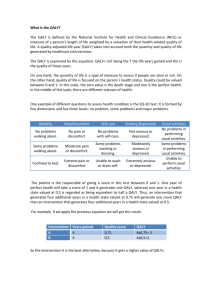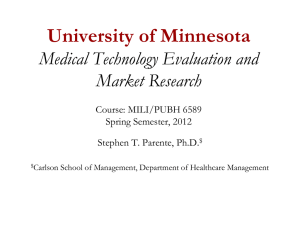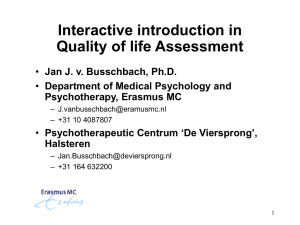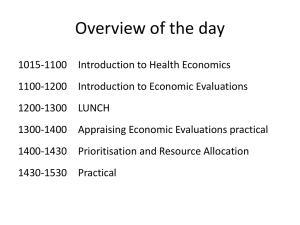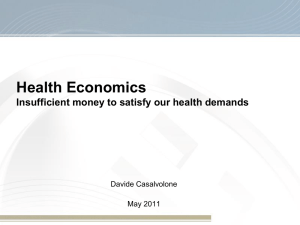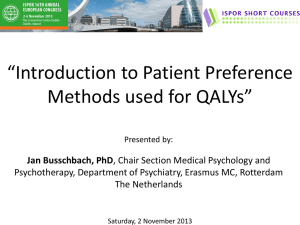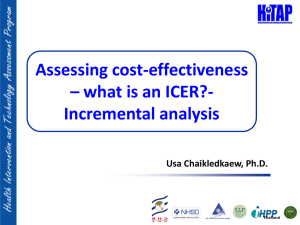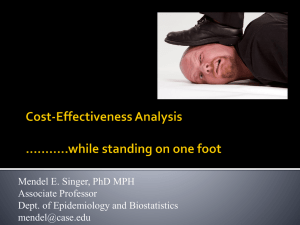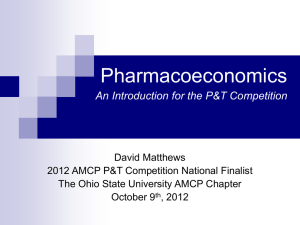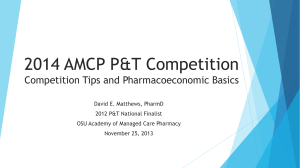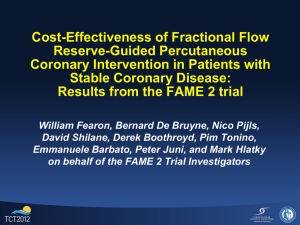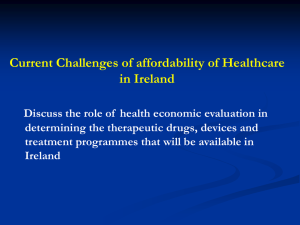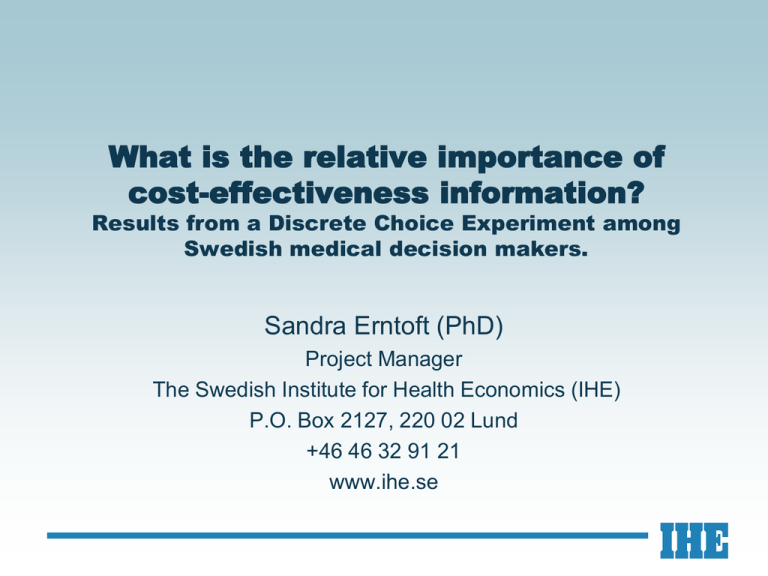
What is the relative importance of
cost-effectiveness information?
Results from a Discrete Choice Experiment among
Swedish medical decision makers.
Sandra Erntoft (PhD)
Project Manager
The Swedish Institute for Health Economics (IHE)
P.O. Box 2127, 220 02 Lund
+46 46 32 91 21
www.ihe.se
2
Background
• Previous research suggests that the relative importance of
cost-effectiveness information varies between
reimbursement-, formulary-, and prescribing - decisions.
• Little research has, however, investigated all three priority
setting context simultanously…
• …and often used different methodologies and methods to
investigate this question.
• Does the potential differences in the importance influence
the threshold values of cost per QALY?
3
Purpose
•
•
•
•
The purpose of the experiment was to investigate the
relative importance of cost-effectiveness information
(cost/QALY) compared with four other criteria;
health status,
expected size of medical effect,
type of medical effect,
budget impact,
AND
which values of a QALY are acceptable to the TLV,
formulary committees and prescribing physicians?
4
Methods
•
A sample of 996 questionnaires (TLV 53; formulary committee members
362; physicians 581).
•
Previous study (Johnson & Backhouse 2006) and focus group
consisting of 5 senior experts).
•
5 criteria – three reflecting need and two economics - 3 levels each.
•
Two questions; A (ranking – ”forced choice”) and B (decision) in order to
identify threshold values.
•
243 possible combinations or approx. 29 000 questions – main effects
only + division into three blocks.
•
Orthogonal design – iterative computer search algorithms in order to
maximize D-efficiency.
•
Conditional logit models.
5
Example of a D C question directed towards the TLV
Criteria
Treatment A
Treatment B
The average health status in
patient population
High degree of
pain/discomfort
Low degree of
pain/discomfort
Type of medical effect
Increased QoL
Life-sustainment
Expected size of medical effect
(effectiveness)
Avoid loss of 1 QALY
Avoid loss of 0.2
QALY
Cost per QALY
102 000 €
28 000 €
Budget Impact
280 000 € per 100 000
inhabitants
18 600 € per 100 000
inhabitants
A) Which treatment is better? (A is better, B is better)
B) Which treatment do You think TLV should reimburse? (A, B,
both A and B, neither A or B)
6
Formulas
A question (ranking):
Uij=αpain*PAIN+αtype_eff*TYPE_EFF+αQALYgain*QALY_GAIN+αcost/QAL
Y*COST_QALY+αbudg.imp.*BUDG_IMP
B question (decision):
Vij=βpain*PAIN+βtype eff* TYPE_EFF+ β QALYgain*QALY_GAIN+ β
cost/QALY*COST_QALY+ β budg.imp.*BUDG_IMP
7
Descriptive statistics
TLV
Form. Com.
Physicians
52,2
54,9
47,3
78
62
43
25
50
0
0
25
86
0
0
2
12
83
N/a
N/a
N/a
17
HE education
(% yes)
58
35
12
Budget/ Operational
responsibility (% yes)
N/a
22
23
Age (mean)
Sex ( % males)
Education:
Physician
Economist
Lawyer
Pharmacist
Other/no answer
Response rate: 21 %
8
Result 1: Relative importance when ranking
pharmaceutical treatments
3.5
3
2.4
2.4
2.5
2.1
2
1.8
1.4
1.5
1
1.8
1.1
1.0 1.0 1.0
0.5
0.9
0.3
0.3
0.4
0.5
0
Cost/QALY
Budg. Imp. Type of med.
eff.
Pain
QALY gain
TLV
Form. Com.
Prescribers
9
Result 2: Relative importance when making a decision
1.6
1.4
1.4
1.2
1.2
1
1.1
1.0 1.0
1.0
0.9
0.8
0.8
0.7
0.6
0.6
0.5
0.4
0.2
0.2
0.2
0.4
0.3
0
Cost/QALY
QALY gain Budg. Imp.
Type med.
eff.
Pain
TLV
Form. Com
Physicians
10
Result 3: Cost-effectiveness threshold values
• 41 cases of statistically significant differences between
decision makers.
• In 28 cases the cost-effectiveness threshold values were lower
rated by the TLV, than by formulary committee members and
prescribing physicians.
Cost per QALY
• TLV: Lowest 43 600 € ; Highest 107 500 €.
• Formulary committees: Lowest - 5 400 € ; Highest 304 200 €
• Physicians: Lowest 4 900 € ; Highest 240 800 €.
1€ = 10,75 SEK (December 2009) ~ 1.3 U.S. $
11
Discussion
• Cost-effectiveness information more important in
reimbursement- than in formulary- and prescribingdecisions. Confirms results from previous research.
• Threshold values are lower in reimbursment- than in
formulary- and prescribing decisions. Can this be
explained by differences in educational backgrounds?
• Higher threshold values in Sweden than in for instance
the Netherlands.
• Willingness to reimburse (WTR) rather than willingness to
pay (WTP) – social utilities rather than individual utilities.
• The WTR is based on the relative value of the public
program (the treatment option rejected) foregone.
12
Conclusions
• Both the relative importance of cost-effectiveness
information and the threshold values of the cost/QALY
varies between decision makers at national, regional and
local level.
• The relatively high threshold values among formulary
committee members and prescribing physicians may be a
sign of a lack of social learning regarding the necessity of
setting priorities due to scarce resources….
• …or a result of the fact that priority setting is more difficult
the closer the decision maker is to the patient.
13
Thank you for your attention!
Sandra Erntoft
Email: Sandra.Erntoft@ihe.se
Phone: +46 46 32 91 21

